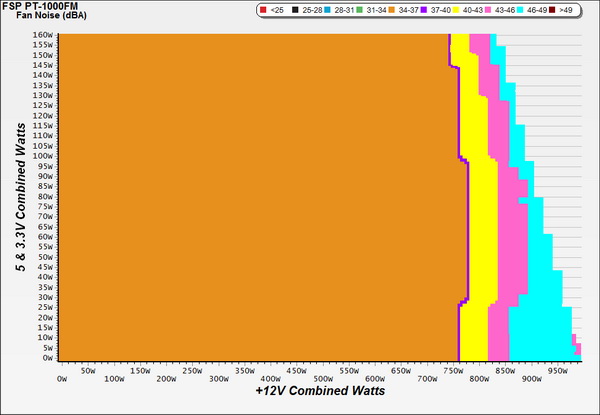FSP Aurum PT 1000W Power Supply Review
FSP's Aurum PT series PSUs are 80 PLUS Platinum-certified and fully modular. Today we will take a look at the series' 1000W mid-level unit.
Why you can trust Tom's Hardware
Efficiency, Temperatures And Noise
Efficiency
Our efficiency testing procedure is detailed here.
Using the results from the previous page, we plotted a chart showing the efficiency of the PT-1000FM at low loads and at loads equal to 10 to 110 percent of the PSU's maximum rated capacity.
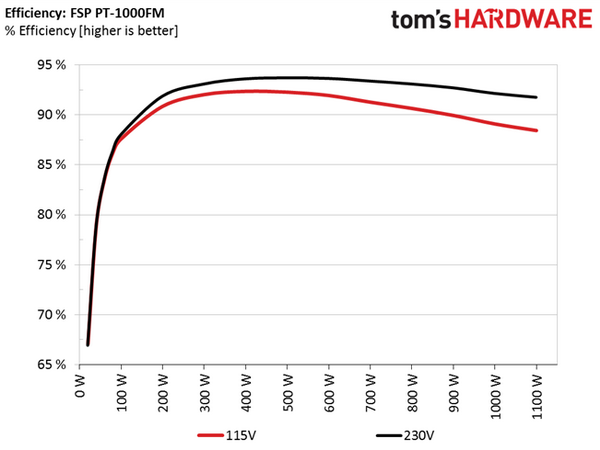
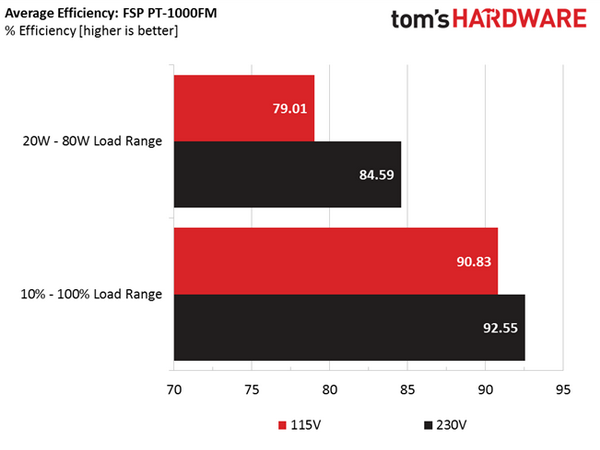

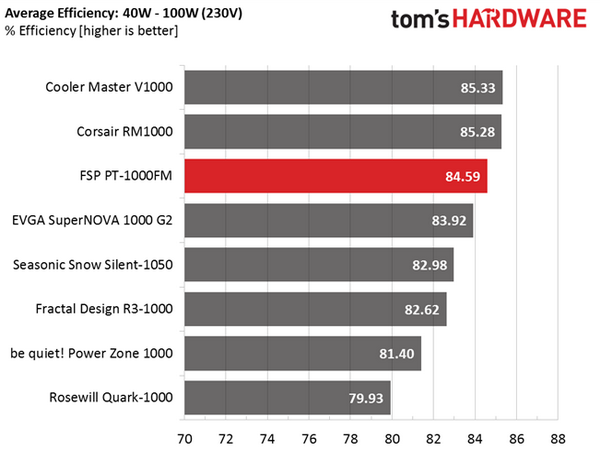
With normal loads, the PT-1000FM took first place in the efficiency tests, performing better than Seasonic's top Platinum-rated platform (XP3). At light loads, FSP's design managed to stay close to the top, with a small difference between Seasonic's Gold Platform that the Cooler Master V1000 uses. Once more, the FSP PSU managed to surpass the Snow Silent 1050, which is considered one of the best PSUs in its category and a direct opponent to the PT-1000FM.
Efficiency At Low Loads
In the next tests, we measure the efficiency of the PT-1000FM at loads significantly lower than 10 percent of the device's maximum capacity (the lowest load the 80 PLUS standard measures). The loads we dialed were 20, 40, 60 and 80W. This is important for representing when a PC is idle with power-saving features turned on.
| Test # | 12V (A/V) | 5V (A/V) | 3.3V (A/V) | 5VSB (A/V) | Power DC/AC (W) | Efficiency (%) | Fan Speed (RPM) | Fan Noise dB(A) | PF/AC (V) |
|---|---|---|---|---|---|---|---|---|---|
| 1 | 1.210A | 0.480A | 0.472A | 0.195A | 19.63 | 67.09 | 900 | 33.6 | 0.833 |
| 12.037V | 5.187V | 3.372V | 5.055V | 29.26 | 114.9V | ||||
| 2 | 2.450A | 0.957A | 0.977A | 0.395A | 39.73 | 79.03 | 900 | 33.6 | 0.924 |
| 12.034V | 5.185V | 3.370V | 5.049V | 50.27 | 115.0V | ||||
| 3 | 3.689A | 1.444A | 1.481A | 0.590A | 59.84 | 83.66 | 900 | 33.6 | 0.954 |
| 12.032V | 5.184V | 3.369V | 5.045V | 71.53 | 115.0V | ||||
| 4 | 4.917A | 1.924A | 1.959A | 0.790A | 79.72 | 86.25 | 900 | 33.6 | 0.968 |
| 12.033V | 5.182V | 3.367V | 5.042V | 92.43 | 115.0V |
At low loads, efficiency stayed at good levels, with two of the four readings coming well above the 80 percent mark. Considering that this is a high-wattage platform, we cannot demand more of it at such light loads.
5VSB Efficiency
The ATX specification states that 5VSB standby supply efficiency should be as high as possible, recommending 50 percent or higher efficiency with 100mA of load, 60 percent or higher with 250mA of load and 70 percent or higher with 1A or more of load.
We will take four measurements: one at 100, 250 and 1000mA, and one with the full load the 5VSB rail can handle.
Get Tom's Hardware's best news and in-depth reviews, straight to your inbox.
| Test # | 5VSB (A/V) | Power DC/AC (W) | Efficiency (%) | PF/AC (V) |
|---|---|---|---|---|
| 1 | 0.102A | 0.52 | 70.27 | 0.061 |
| 5.064V | 0.74 | 115.1V | ||
| 2 | 0.252A | 1.28 | 73.99 | 0.134 |
| 5.062V | 1.73 | 115.1V | ||
| 3 | 1.002A | 5.06 | 78.45 | 0.316 |
| 5.048V | 6.45 | 115.0V | ||
| 4 | 3.002A | 15.04 | 74.71 | 0.439 |
| 5.010V | 20.13 | 115.0V |
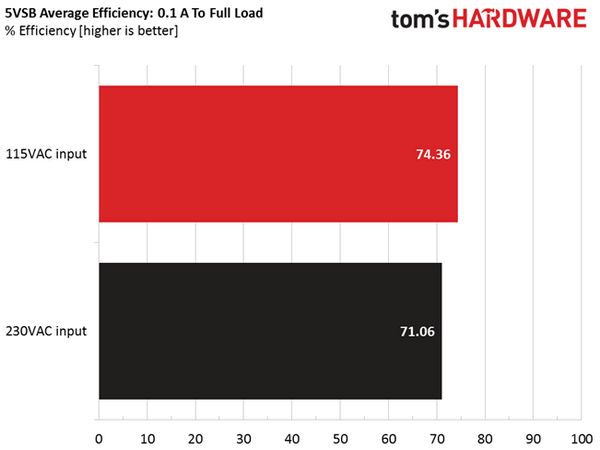
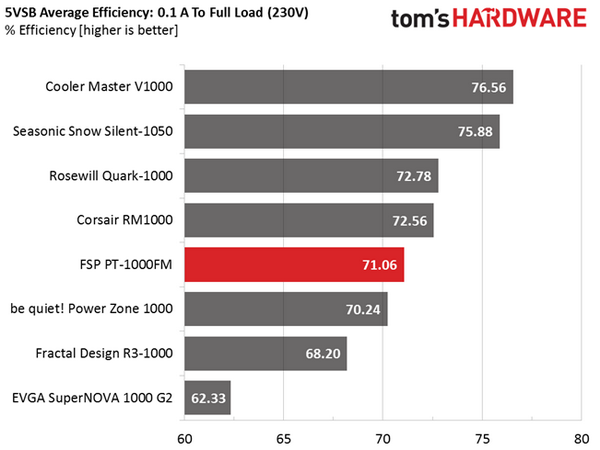
The 5VSB rail wasn't very efficient, despite the MOSFET that it uses for regulation. As a result, the PSU lags behind its competition in this test. FSP should improve this rail to bring it closer to the performance of the other rails.
Power Consumption In Idle And Standby
| Mode | 12V | 5V | 3.3V | 5VSB | Power (AC) | PF/AC (V) |
|---|---|---|---|---|---|---|
| Idle | 12.039V | 5.191V | 3.375V | 5.066V | 10.32W | 0.502 |
| 115.0V | ||||||
| Standby | 0.07W | 0.006 | ||||
| 115.2V |

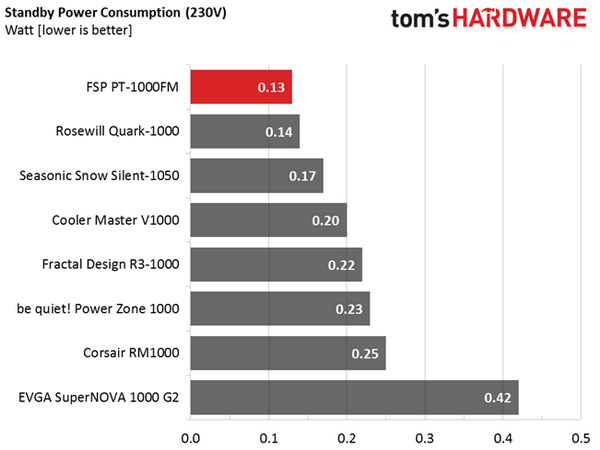
In the table above, you'll find the power consumption and voltage values of all rails (except -12V) when the PSU is in idle mode (powered on, but without any load on its rails), and the power consumption when the PSU is in standby mode (without any load at 5VSB).
Phantom power is very low on this unit, which will save your wallet and also protect the environment, since less energy goes to waste.
Fan RPM, Delta Temperature And Output Noise
Our mixed noise testing is described in detail here.
The following chart illustrates the cooling fan's speed (RPMs) and the delta between input and output temperature. The results were obtained at 35 to 48 °C ambient temperature.
The next chart shows the cooling fan's speed (RPMs) and output noise. We measured acoustics from one meter away, inside a small, custom-made anechoic chamber with internals completely covered in soundproofing material (be quiet! Noise Absorber kit). Background noise inside the anechoic chamber was below 18 dB(A) during testing, and the results were obtained with the PSU operating at 35 to 48 °C ambient temperature.

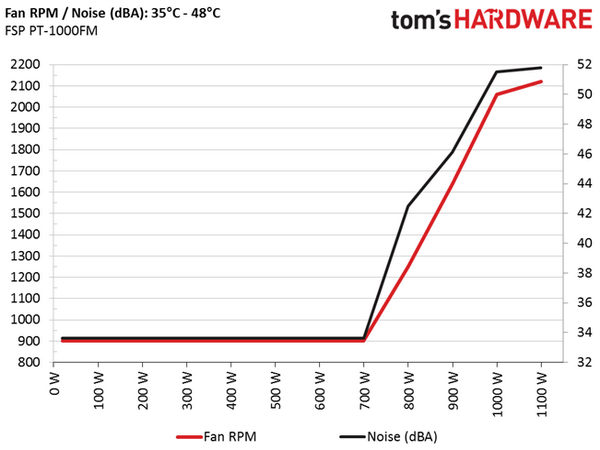
The following graph illustrates the fan's output noise over the entire operating range of the PSU. The same conditions of the above graph apply to our measurements, though the ambient temperature was between 28 and 30 °C.
The fan operates at 900 RPM throughout most of the PSU's range. At around 750 to 900W, output noise increases significantly, exceeding 40 dB(A). Close to full load it reaches 50 dB(A), meaning that it will be annoying even to those who are not sensitive to noise. However, you shouldn't expect a 1kW unit to be silent under full load since even a highly efficient unit like the PT1000-FM will still have significant heat to deal with.
In general, this is a quiet PSU given its high wattage. But we believe that if FSP offered a semi-passive mode, the final result would have been much better since overall output noise would be significantly reduced. If FSP didn't want to mess with the semi-passive mode, it should at least lower the minimum fan speed. At 900 RPM, it's still pretty aggressive.
Current page: Efficiency, Temperatures And Noise
Prev Page Load Regulation, Hold-Up Time And Inrush Current Next Page Cross-Load Tests And Infrared Images
Aris Mpitziopoulos is a contributing editor at Tom's Hardware, covering PSUs.
-
Giannis Karagiannis Just ordered one! Very comprehensive review! It is a bit strange that thanks to your recent articles I can choose a power supply with much greater confidence than a CPU or VGA. Keep up the good work!Reply -
Vosgy ReplyJust ordered one! Very comprehensive review! It is a bit strange that thanks to your recent articles I can choose a power supply with much greater confidence than a CPU or VGA. Keep up the good work!
Man haven't seen anyone call them Video Graphics Accelerators in years, kudos to you good sir. -
Covaylent Nice work, Aris, as usual.Reply
Would you mind commenting on the infrared images? Some of those hotspots seem quite hot - am I just reading the images incorrectly? -
Aris_Mp Indeed some hotspots are very hot since I usually take this shots with the PSU operating at very high ambient temperatures. Some parts inside the PSU may operate at up to 100C under such conditions.Reply
